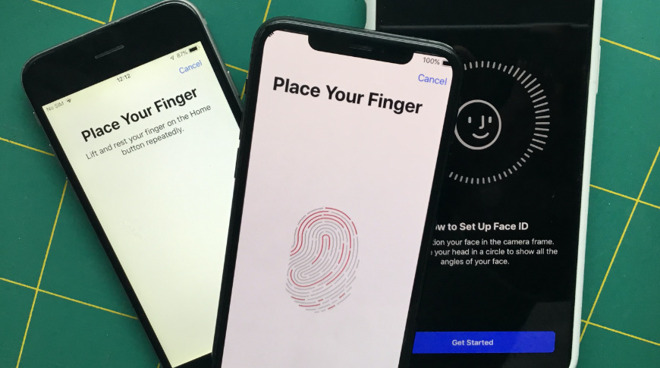Apple reportedly testing in-screen Touch ID for the next iPhone
The next iPhone could feature both Face ID and a version of Touch ID using an optical fingerprint scanner built into the display.

Touch ID and Face ID
Following many previous reports that Apple has been investigating under-display optical Touch ID, a new claim says that the feature is in testing. If correct, it backs up predictions that the technology will appear in the "iPhone 13."
According to the Wall Street Journal, two unnamed former Apple employees have confirmed that a new optical Touch ID may be featured alongside the existing Face ID.
One former employee previously worked on Touch ID and said that an optical version could be more reliable than the existing ultrasonic technique. However, this source also said that Apple would not adopt optical fingerprint sensing unless it proved to be as secure as the current Touch ID.
Touch ID is currently used in the iPhone SE, iPad, and MacBooks. Most recently, Apple moved the Touch ID sensor to the sleep/wake button on the iPad Air 4.

Touch ID and Face ID
Following many previous reports that Apple has been investigating under-display optical Touch ID, a new claim says that the feature is in testing. If correct, it backs up predictions that the technology will appear in the "iPhone 13."
According to the Wall Street Journal, two unnamed former Apple employees have confirmed that a new optical Touch ID may be featured alongside the existing Face ID.
One former employee previously worked on Touch ID and said that an optical version could be more reliable than the existing ultrasonic technique. However, this source also said that Apple would not adopt optical fingerprint sensing unless it proved to be as secure as the current Touch ID.
Touch ID is currently used in the iPhone SE, iPad, and MacBooks. Most recently, Apple moved the Touch ID sensor to the sleep/wake button on the iPad Air 4.

Comments
I would like to see security options that could allow requirements for both Touch and Face ID (and possibly passcode), combinations of these, or none of them (security off).
I also want to see a “poison finger” option where, if a certain finger is used on the fingerprint scanner, the phone is disabled and wiped.
https://www.valuewalk.com/2020/01/slow-galaxy-s10-fingerprint-sensor/
https://www.samsung.com/us/support/troubleshooting/TSG01200322/
https://thedroidguy.com/fix-s10-fingerprint-scanner-not-working-1101193
https://www.reddit.com/r/galaxys10/comments/bj4x9m/still_experiencing_fingerprint_scanner_issues/
2. New features that are "Apple first" don't always work flawlessly out of the gate. They also don't always succeed! Instead it is the features that have become popular and refined from years of use on hundreds of millions of Android devices first that are more likely to be very popular and well implemented initially on Apple products.
3. Despite everyone claiming "Apple did it right" or "waited until it was ready", Apple features that are adopted after having been in use on Android devices for years don't work any better (5G, NFC, widgets, stylus support, OLED screens, phablet form factors, set top boxes with app stores) and at times are even behind the Android implementation and need years to catch up. Case in point: HomePod.
Apple is still with the waterfall SDLC while Google relies on agile. That means the latter comes out with more products faster, but at the cost of having a lot more products be half-baked and ultimately fail. Samsung for their part is SDLC like Apple, but unlike Apple they do their own manufacturing and are a leader in components and the basic engineering/physics behind them. So a lot of features are going to be in Samsung phones first merely because Samsung themselves invented the components for those features.
It is no big deal: it just means that Apple's strengths are in other areas. But Google and Samsung have their own strengths and you should just go ahead and admit that Apple copies and benefits from those strengths on a regular basis. I myself prefer benefiting from new tech early instead of waiting 3-4 years until Apple is able to polish it nice and shiny. That is why I obtained my first phablet years before Apple introduced one - and years more before Apple's phablets actually had OS functionality to make it more than merely the same phone with a bigger screen - and on that phone was using Google Wallet years before Apple introduced Apple Pay, and why in a few months I am going to trade in my Galaxy Note 20 for a Galaxy Fold 3 (again at least a couple of years before Apple gets around to it).